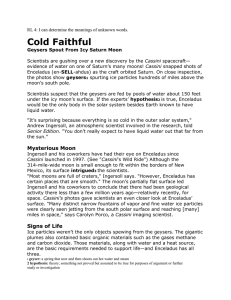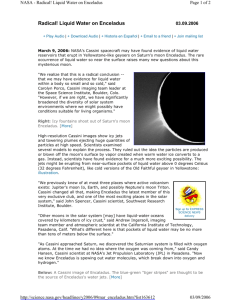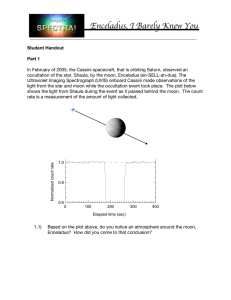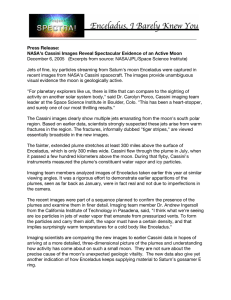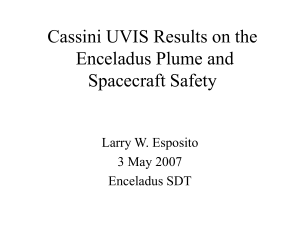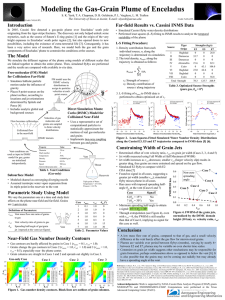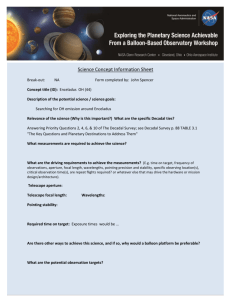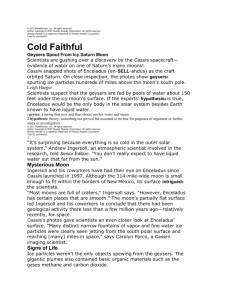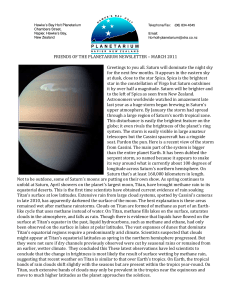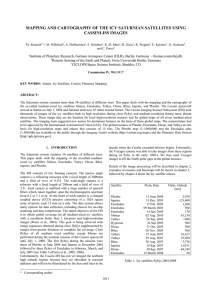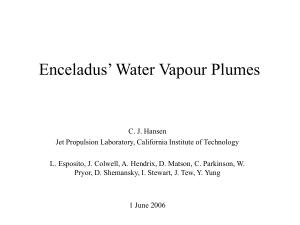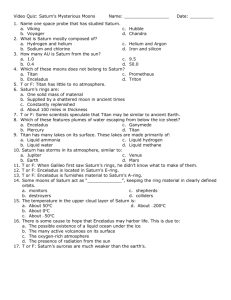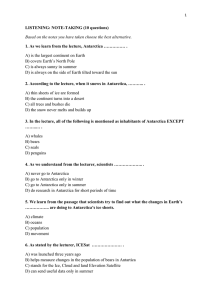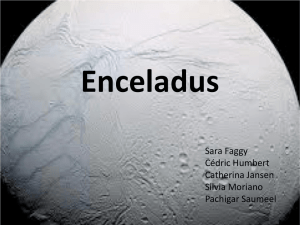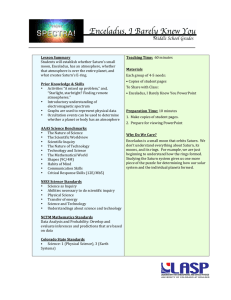Jones Arridge Cassin.. - University of Hertfordshire
advertisement
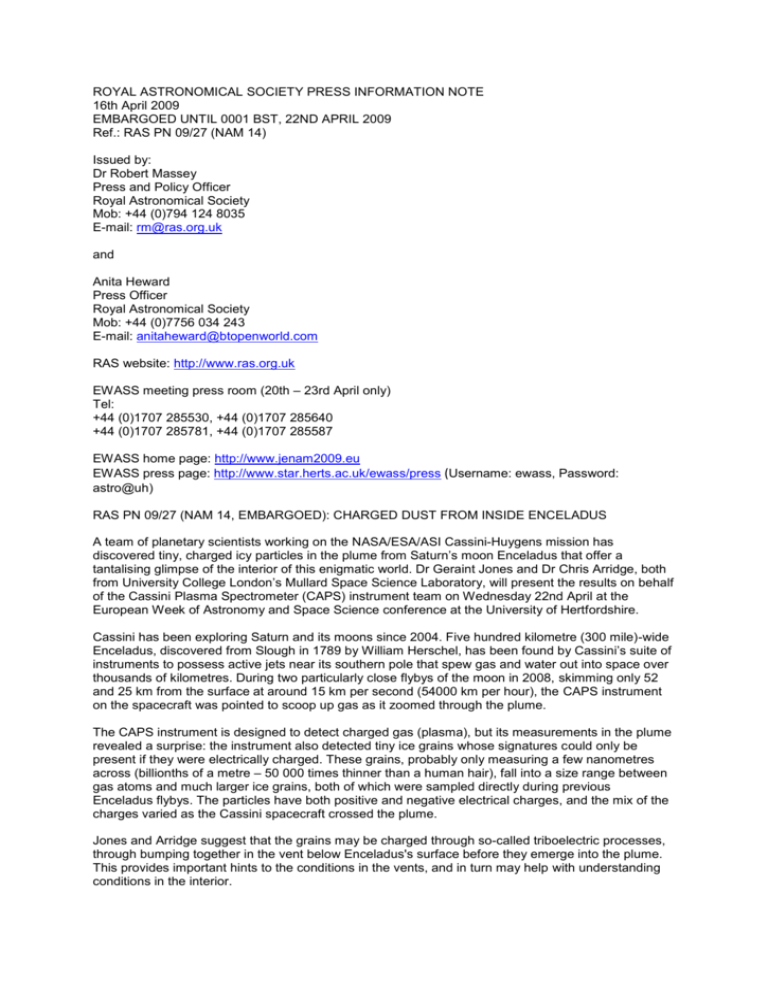
ROYAL ASTRONOMICAL SOCIETY PRESS INFORMATION NOTE 16th April 2009 EMBARGOED UNTIL 0001 BST, 22ND APRIL 2009 Ref.: RAS PN 09/27 (NAM 14) Issued by: Dr Robert Massey Press and Policy Officer Royal Astronomical Society Mob: +44 (0)794 124 8035 E-mail: rm@ras.org.uk and Anita Heward Press Officer Royal Astronomical Society Mob: +44 (0)7756 034 243 E-mail: anitaheward@btopenworld.com RAS website: http://www.ras.org.uk EWASS meeting press room (20th – 23rd April only) Tel: +44 (0)1707 285530, +44 (0)1707 285640 +44 (0)1707 285781, +44 (0)1707 285587 EWASS home page: http://www.jenam2009.eu EWASS press page: http://www.star.herts.ac.uk/ewass/press (Username: ewass, Password: astro@uh) RAS PN 09/27 (NAM 14, EMBARGOED): CHARGED DUST FROM INSIDE ENCELADUS A team of planetary scientists working on the NASA/ESA/ASI Cassini-Huygens mission has discovered tiny, charged icy particles in the plume from Saturn’s moon Enceladus that offer a tantalising glimpse of the interior of this enigmatic world. Dr Geraint Jones and Dr Chris Arridge, both from University College London’s Mullard Space Science Laboratory, will present the results on behalf of the Cassini Plasma Spectrometer (CAPS) instrument team on Wednesday 22nd April at the European Week of Astronomy and Space Science conference at the University of Hertfordshire. Cassini has been exploring Saturn and its moons since 2004. Five hundred kilometre (300 mile)-wide Enceladus, discovered from Slough in 1789 by William Herschel, has been found by Cassini’s suite of instruments to possess active jets near its southern pole that spew gas and water out into space over thousands of kilometres. During two particularly close flybys of the moon in 2008, skimming only 52 and 25 km from the surface at around 15 km per second (54000 km per hour), the CAPS instrument on the spacecraft was pointed to scoop up gas as it zoomed through the plume. The CAPS instrument is designed to detect charged gas (plasma), but its measurements in the plume revealed a surprise: the instrument also detected tiny ice grains whose signatures could only be present if they were electrically charged. These grains, probably only measuring a few nanometres across (billionths of a metre – 50 000 times thinner than a human hair), fall into a size range between gas atoms and much larger ice grains, both of which were sampled directly during previous Enceladus flybys. The particles have both positive and negative electrical charges, and the mix of the charges varied as the Cassini spacecraft crossed the plume. Jones and Arridge suggest that the grains may be charged through so-called triboelectric processes, through bumping together in the vent below Enceladus's surface before they emerge into the plume. This provides important hints to the conditions in the vents, and in turn may help with understanding conditions in the interior. Drs Jones and Arridge are intrigued by what their discovery reveals about Enceladus: “What are particularly fascinating are the bursts of dust that CAPS detects when Cassini passes through the individual jets in the plume” says Jones. “Each jet is split according to charge though”, adds Arridge, “Negative grains are on one side, and positive ones on the other”. As Arridge will explain in his presentation, as these charged grains travel away from Enceladus, their paths are bent by electric and magnetic fields in Saturn's giant magnetosphere. In this way Saturn's magnetosphere acts as an enormous mass spectrometer for the plume particles, allowing scientists to constrain their masses. Arridge has begun modelling the paths of these newly-discovered particles. Ionised gas (plasma) in Saturn’s magnetosphere flows past Enceladus at over 80000 km per hour. Arridge’s results show that for this enormous mass spectrometer to work and for these dust particles to reach Cassini, this river of plasma must be significantly slowed down, in and near the plume, to speeds of less than 3200 km per hour. This slowing of the plasma is a result of the plume injecting particles into the plasma stream - making the whole flow slow down in a similar effect to when cars join a busy motorway. These new results provide further evidence that the material in the Enceladus plume has a huge influence on the moon’s surroundings. Future Cassini flybys will help further understand the processes that occur at Enceladus and in its vicinity. William Herschel could not have suspected that the tiny point of light that he found in 1789 would turn out to be such an exotic place. CONTACTS Dr Geraint Jones UCL Mullard Space Science Laboratory Department of Space and Climate Physics University College London Holmbury St. Mary Dorking Surrey RH5 6NT United Kingdom Tel: +44 (0)1483 204 263 Mob: +44 (0)7941 725 473 E-mail: ghj@mssl.ucl.ac.uk Dr Chris Arridge UCL Mullard Space Science Laboratory Department of Space and Climate Physics University College London Holmbury St. Mary Dorking Surrey RH5 6NT United Kingdom Tel: +44 (0) 1483 204 150 Mob: +44 (0) 7790 012 457 E-mail: csa@mssl.ucl.ac.uk IMAGE An image showing the plume measured by CAPS relative to Enceladus is available from http://www.mssl.ucl.ac.uk/~ghj/jenam/ Caption: Observations from the Cassini Plasma Spectrometer (CAPS) made during the Cassini flyby of Enceladus on 12th March 2008, superimposed on Cassini’s path. As the spacecraft passed the moon, CAPS detected streams of charged particles in individual jets within the plume; negative particles are shown in this view. Each ribbon in the image gives an indication of the measured particle energy per charge: high energy particle fluxes are shown nearest Enceladus, and lower energy particles are farthest. The red points marked on Enceladus show the locations of known jet sources found by other Cassini instruments. Credit: MSSL-UCL. CASSINI The Cassini/Huygens mission is an international mission funded by NASA, ESA and the Italian Space Agency (ASI). Cassini was launched on 15 October 1997 and entered orbit around Saturn on 1 July 2004. The Cassini Plasma Spectrometer (CAPS) investigation is an international consortium of universities and research laboratories from the USA, UK, France, Hungary, Norway, and Finland. CAPS is led by the Principal Investigator, Dr. David T. Young, of Southwest Research Institute, San Antonio, Texas, USA. University College London’s Mullard Space Science Laboratory is part of this consortium and designed, built, and operates the Electron Spectrometer (ELS) instrument which played a significant role in detecting these particles. MSSL’s Prof. Andrew Coates is the lead coinvestigator for ELS. For more information about Cassini see: http://saturn.jpl.nasa.gov THE EUROPEAN WEEK OF ASTRONOMY AND SPACE SCIENCE More than 1000 astronomers and space scientists will gather at the University of Hertfordshire for the European Week of Astronomy and Space Science (EWASS), incorporating the 2009 Royal Astronomical Society National Astronomy Meeting (NAM 2009) and the European Astronomical Society Joint Meeting (JENAM 2009). The meeting runs from 20th to 23rd April 2009. EWASS is held in conjunction with the UK Solar Physics (UKSP) and Magnetosphere Ionosphere and Solar-Terrestrial Physics (MIST) meetings. The conference includes scientific sessions organised by the European Organisation for Astronomical Research in the Southern Hemisphere (ESO) and the European Space Agency (ESA). EWASS is principally sponsored by the Royal Astronomical Society (RAS), the Science and Technology Facilities Council (STFC) and the University of Hertfordshire, Hatfield. THE ROYAL ASTRONOMICAL SOCIETY The Royal Astronomical Society (RAS), founded in 1820, encourages and promotes the study of astronomy, solar-system science, geophysics and closely related branches of science. The RAS organizes scientific meetings, publishes international research and review journals, recognizes outstanding achievements by the award of medals and prizes, maintains an extensive library, supports education through grants and outreach activities and represents UK astronomy nationally and internationally. Its more than 3000 members (Fellows), a third based overseas, include scientific researchers in universities, observatories and laboratories as well as historians of astronomy and others.
